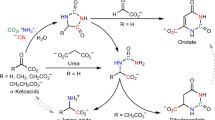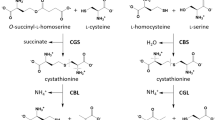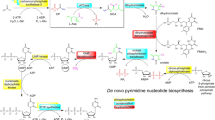Abstract
FOR some years there has been indirect evidence (reviewed, for example, by Woods1) that p-amino-benzoate has a function in the synthesis by micro-organisms of certain nucleic acid components and amino-acids. In the case of the former substances it is probable that the effect occurs through the intermediate formation of folic acid (pteroylglutamate) or related compounds which contain a p-aminobenzoate residue. One of the amino-acids implicated above is serine2, and this was chosen for the present studies since Sakami3, working with animal tissues, has shown its formation by condensation of glycine with a one-carbon compound such as formate. There is also evidence with several micro-organisms that glycine is a precursor of serine4,5. Holland and Meinke6 have found that under certain limited conditions Streptococcus fæcalis R requires serine for growth, and that such requirement may be largely abolished by increasing tenfold the concentration of pteroylglutamate.
This is a preview of subscription content, access via your institution
Access options
Subscribe to this journal
Receive 51 print issues and online access
$199.00 per year
only $3.90 per issue
Buy this article
- Purchase on Springer Link
- Instant access to full article PDF
Prices may be subject to local taxes which are calculated during checkout
Similar content being viewed by others
References
Woods, D. D., Ann. N.Y. Acad. Sci., 52, 1199 (1950).
Winkler, K. C., and de Haan, P. G., Arch. Biochem., 18, 97 (1948).
Sakami, W., J. Biol. Chem., 176, 995 (1948).
Roepke, R. R., Libby, R. L., and Small, M. H., J. Bact., 48, 401 (1944).
Ehrensvärd, G., Sperber, E., Saluste, E., Reio, L., and Stjernholm, R., J. Biol. Chem., 169, 759 (1947).
Holland, B. R., and Meinke, W. W., J. Biol. Chem., 178, 7 (1949).
Steele, B. F., Sauberlich, H. E., Reynolds, M. S., and Baumann, C. A., J. Biol. Chem., 177, 533 (1949).
Rainbow, C., Nature, 162, 572 (1948).
Bond, T. J., Bardos, T. J., Sibley, M., and Shive, W., J. Amer. Chem. Soc., 71, 3852 (1949).
Plaut, G. W. E., Betheil, J. J., and Lardy, H. A., J. Biol. Chem., 184, 795 (1950).
Lyman, C. M., Moseley, O., Wood, S., Butler, B., and Hale, F., J. Biol. Chem., 167, 177 (1947).
Author information
Authors and Affiliations
Rights and permissions
About this article
Cite this article
LASCELLES, J., WOODS, D. Synthesis of Serine by Micro-organisms. Nature 166, 649–650 (1950). https://doi.org/10.1038/166649a0
Issue Date:
DOI: https://doi.org/10.1038/166649a0
This article is cited by
-
Some analogies between prebiotic thermal conversions of glycine and metabolic pathways
Origins of Life (1984)
-
Formation of an arylamine by a sulfanilamide-resistant strain ofBacillus subtilis
Proceedings / Indian Academy of Sciences (1958)
-
The metabolism of serine in pyridoxine deficiency
Proceedings / Indian Academy of Sciences (1957)
-
Participation of Pyridoxal Phosphate in the Enzymic Synthesis of Serine
Nature (1954)
Comments
By submitting a comment you agree to abide by our Terms and Community Guidelines. If you find something abusive or that does not comply with our terms or guidelines please flag it as inappropriate.



